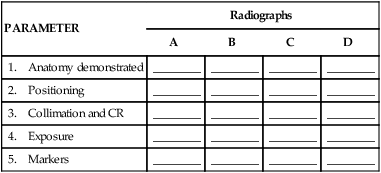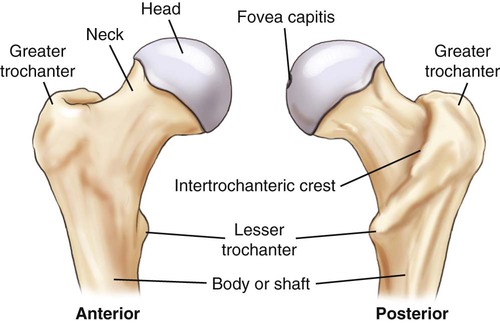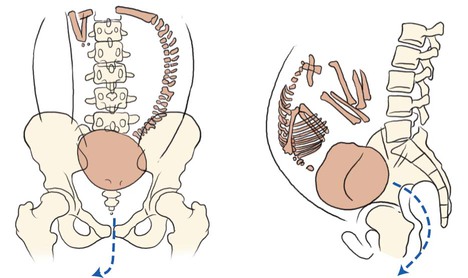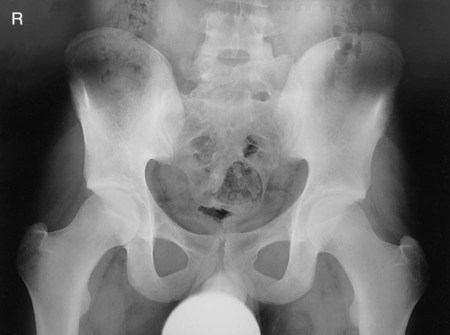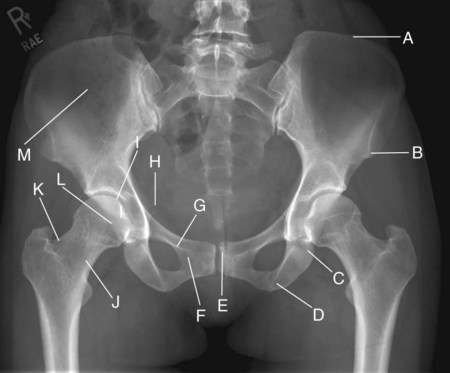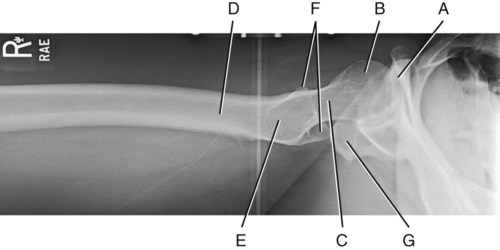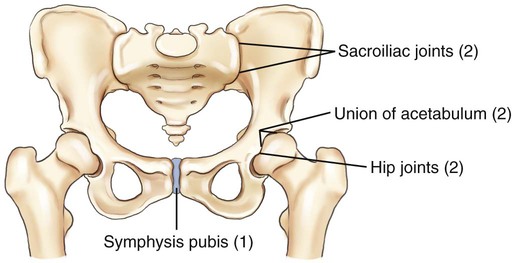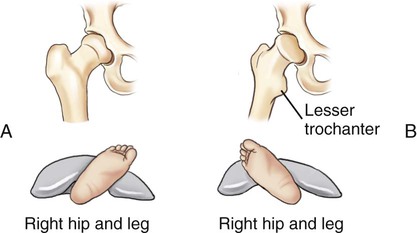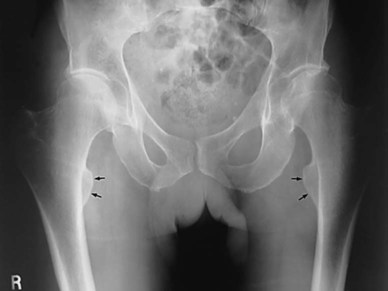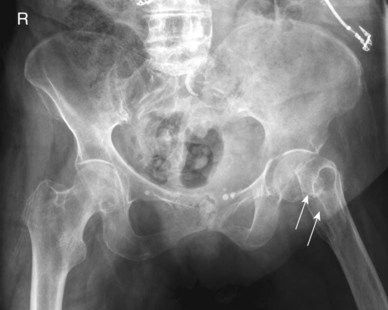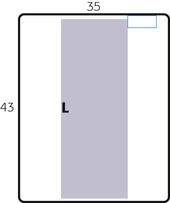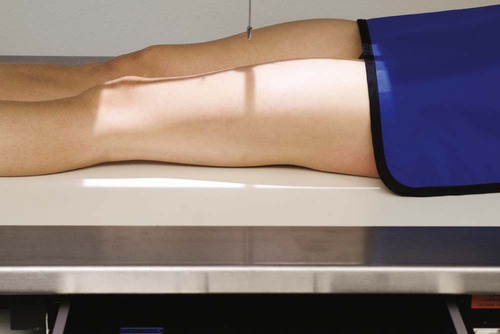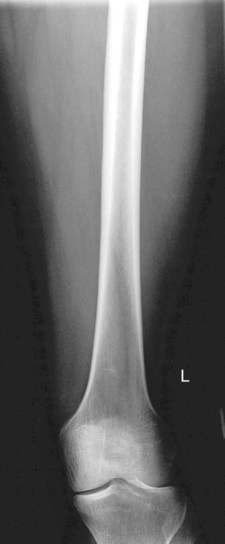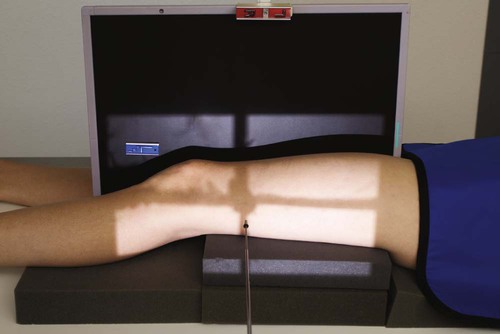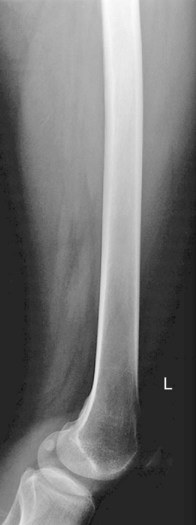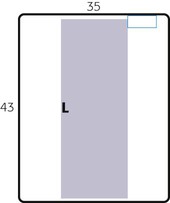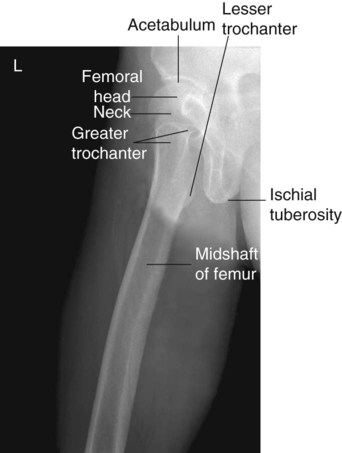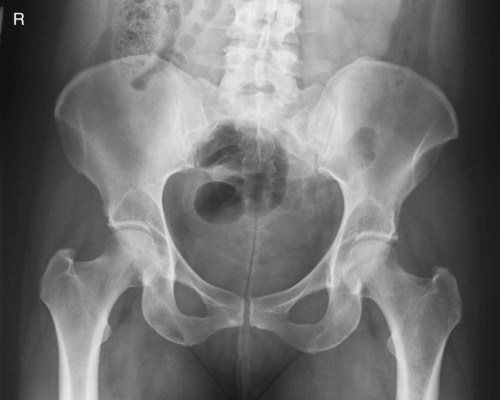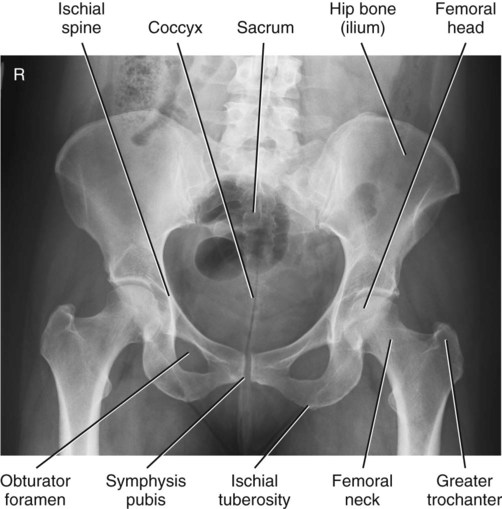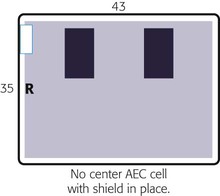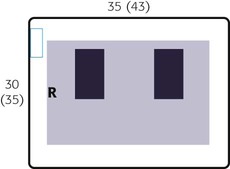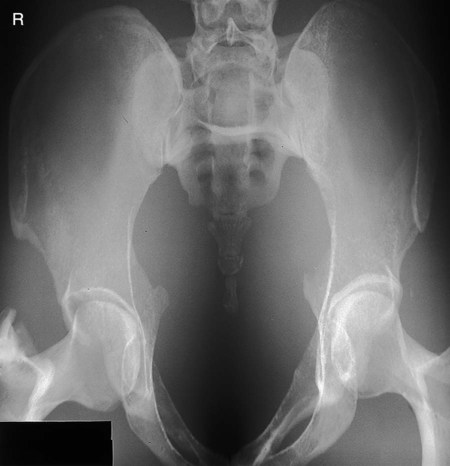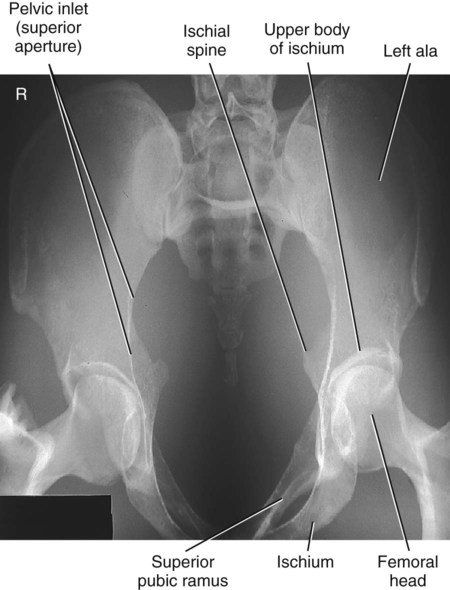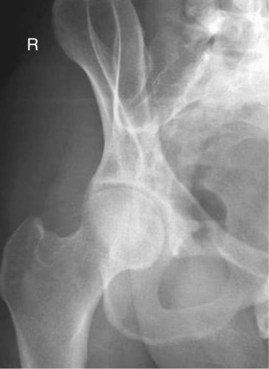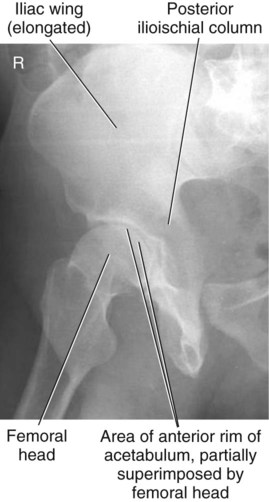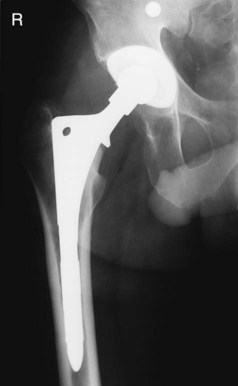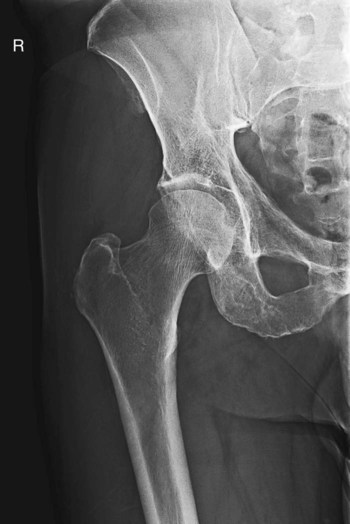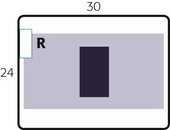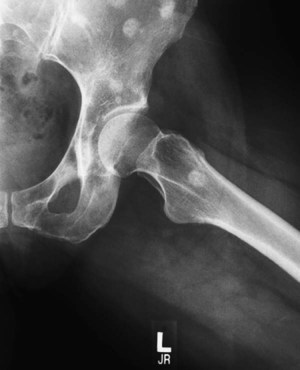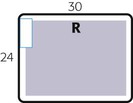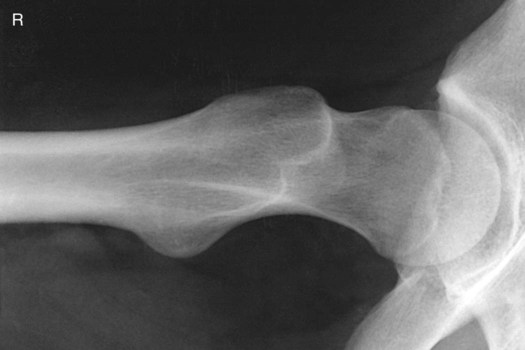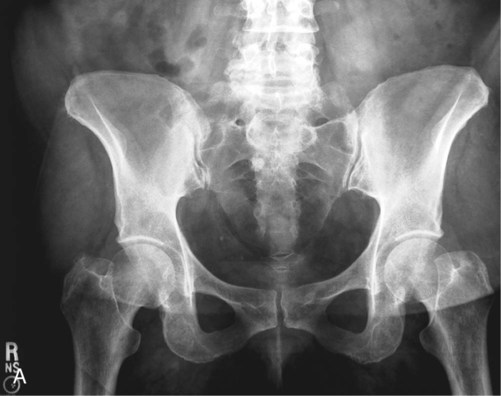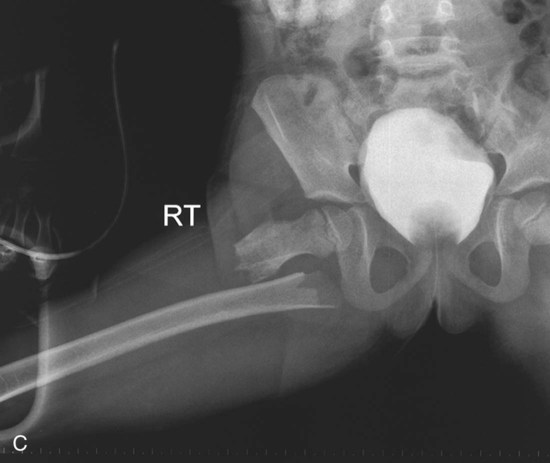Femur and Pelvic Girdle
Radiographic Anatomy
Lower Limb (Extremity)
In Chapter 6, three groups of bones of the lower limb—the foot, leg, and distal femur—were described, along with the associated knee and ankle joints.
The lower limb bones discussed in this chapter are the proximal femur and the pelvic girdle. The joints involving these two groups of bones, also included in this chapter, are the important hip joint and the sacroiliac and symphysis pubis joints of the pelvic girdle.
Femur
The femur is the longest and strongest bone in the body. The entire weight of the body is transferred through this bone and the associated joints at each end. Therefore, these joints are a frequent source of pathology when trauma occurs. The anatomy of the mid- to distal femur was discussed in Chapter 6.
Proximal Femur
The proximal femur consists of four essential parts, the head (1), neck (2), and greater (3) and lesser trochanters (4) (tro-kan′-ters).
The head of the femur is rounded and smooth for articulation with the hip bones. It contains a depression, or pit, near its center called the fovea capitis (fo′-ve-ah cap′-i-tis), wherein a major ligament called the ligament of the head of the femur, or the ligament capitis femoris, is attached to the head of the femur.
The neck of the femur is a strong pyramidal process of bone that connects the head with the body or shaft in the region of the trochanters.
The greater trochanter is a large prominence that is located superiorly and laterally to the femoral shaft and is palpable as a bony landmark. The lesser trochanter is a smaller, blunt, conical eminence that projects medially and posteriorly from the junction of the neck and shaft of the femur. The trochanters are joined posteriorly by a thick ridge called the intertrochanteric (in″-ter-tro″-kan-ter′-ik) crest. The body or shaft of the femur is long and almost cylindrical.
The angle of the neck to the shaft on an average adult is approximately 125°, with a variance of ±15°, depending on the width of the pelvis and the length of the lower limbs. For example, in a long-legged person with a narrow pelvis, the femur would be nearer vertical, which then would change the angle of the neck to about 140°. This angle would be less (110° to 115°) for a shorter person with a wider pelvis.
On an average adult in the anatomic position, the longitudinal plane of the femur is about 10° from vertical, as shown on the left in Fig. 7-3. This vertical angle is nearer 15° on someone with a wide pelvis and shorter limbs and only about 5° on a long-legged person. This angle affects positioning and the central ray (CR) angles for a lateral knee, as described in Chapter 6, p. 215, Fig. 6-20.
Another angle of the neck and head of the femur that is important in radiography is the 15° to 20° anterior angle of the head and neck in relation to the body of the femur (see right drawing of Fig. 7-3). The head projects somewhat anteriorly or forward as a result of this angle. This angle becomes important in radiographic positioning; the femur and leg must be rotated 15° to 20° internally to place the femoral neck parallel to the image receptor (IR) for a true anteroposterior (AP) projection of the proximal femur.
Pelvis
The complete pelvis (meaning a basin) serves as the base of the trunk and forms the connection between the vertebral column and lower limbs. The pelvis consists of four bones—two hip bones (ossa coxae, also called innominate bones), one sacrum (sa′-krum), and one coccyx (kok′-siks).
Sometimes the term pelvic girdle is used in reference to the complete pelvis. This term, however, is incorrect in that the pelvic girdle consists only of the two hip (innominate) bones, whereas the term pelvis includes four bones, the right and left hip (innominate) bones, the sacrum, and the coccyx.*
NOTE: The sacrum and the coccyx also are considered parts of the distal vertebral column and in this textbook are discussed in Chapter 9, along with the lumbar spine.
Hip Bone
Each hip bone is composed of three divisions: (1) ilium (il′-e-um), (2) ischium (is′-ke-um), and (3) pubis (pu′-bis). In a child, these three divisions are separate bones, but they fuse into one bone during the middle teens. The fusion occurs in the area of the acetabulum (as″-e-tab′-u-lum). The acetabulum is a deep, cup-shaped cavity that accepts the head of the femur to form the hip joint.
The ilium, the largest of the three divisions, is located superior to the acetabulum. The ischium is inferior and posterior to the acetabulum, whereas the pubis is inferior and anterior to the acetabulum. Each of these three parts is described in detail in the following sections.
Ilium
Each ilium is composed of a body and an ala, or wing. The body of the ilium is the more inferior portion near the acetabulum and includes the superior two-fifths of the acetabulum. The ala, or wing portion, is the thin and flared superior part of the ilium.
The crest of the ilium is the superior margin of the ala; it extends from the anterior superior iliac spine (ASIS) to the posterior superior iliac spine (PSIS). In radiographic positioning, the uppermost peak of the crest often is referred to as the iliac crest, but it actually extends between the ASIS and the PSIS.
Below the ASIS is a less prominent projection referred to as the anterior inferior iliac spine. Similarly, inferior to the PSIS is the posterior inferior iliac spine.
Ischium
The ischium is that part of the hip bone that lies inferior and posterior to the acetabulum. Each ischium is divided into a body and a ramus. The superior portion of the body of the ischium makes up the posteroinferior two-fifths of the acetabulum. The lower portion of the body of the ischium (formerly called the superior ramus) projects caudally and medially from the acetabulum, ending at the ischial tuberosity. Projecting anteriorly from the ischial tuberosity is the ramus of the ischium.
The rounded roughened area near the junction of the lower body and the inferior rami is a landmark called the tuberosity of the ischium, or the ischial (is′-ke-al) tuberosity.
Posterior to the acetabulum is a bony projection termed the ischial spine. A small part of the ischial spine also is visible on a frontal view of the pelvis, as shown in Fig. 7-8. (It is also seen in the anatomy review radiograph, Fig. 7-17.)
Directly superior to the ischial spine is a deep notch termed the greater sciatic notch. Inferior to the ischial spine is a smaller notch termed the lesser sciatic notch.
The ischial tuberosities bear most of the weight of the body when an individual sits. They can be palpated through the soft tissues of each buttock in a prone position. However, because of discomfort and possible embarrassment to the patient, this landmark is not used as commonly as the previously described ASIS and crest of the ilium.
Pubis
The last of the three divisions of one hip bone is the pubis, or pubic bone. The body of the pubis is anterior and inferior to the acetabulum and includes the anteroinferior one-fifth of the acetabulum.
Extending anteriorly and medially from the body of each pubis is a superior ramus. The two superior rami meet in the midline to form an amphiarthrodial joint, the symphysis pubis (sim′-fi-sis pu′-bis), which also is correctly called the pubic symphysis. Each inferior ramus passes down and posterior from the symphysis pubis to join the ramus of the respective ischium.
The obturator foramen (ob′-tu-ra″-tor fo-ra′-men) is a large opening formed by the ramus and body of each ischium and by the pubis. The obturator foramen is the largest foramen in the human skeletal system.
The crests of the ilium and ASIS are important positioning landmarks. The superior margin of the symphysis pubis is a possible landmark for pelvis and hip positioning, as well as for positioning of the abdomen, because it defines the inferior margin of the abdomen. However, if other associated landmarks are available, the symphysis pubis generally is not used as a palpated landmark because of patient modesty and potential embarrassment.
Summary of Topographic Landmarks
Important positioning landmarks of the pelvis are reviewed in Fig. 7-9. The most superior aspect of the iliac crest and the ASIS are easily palpated. The ASIS is one of the more frequently used positioning landmarks of the pelvis. It also is commonly used to check for rotation of the pelvis and/or lower abdomen by determination of whether the distance between the ASIS and the tabletop is equal on both sides.
The greater trochanter of the femur can be located by firm palpation of the soft tissues of the upper thigh. Note that the prominence of the greater trochanter is at about the same level as the superior border of the symphysis pubis, whereas the ischial tuberosity is  to 2 inches (4 to 5 cm) below the symphysis pubis. These distances vary between a male and a female pelvis because of general differences in shape, as described later in this chapter.
to 2 inches (4 to 5 cm) below the symphysis pubis. These distances vary between a male and a female pelvis because of general differences in shape, as described later in this chapter.
True and False Pelvis
A plane through the brim of the pelvis divides the pelvic area into two cavities. The pelvic brim is defined by the superior portion of the symphysis pubis anteriorly and by the superior, prominent part of the sacrum posteriorly. The general area above or superior to the oblique plane through the pelvic brim is termed the greater, or false, pelvis. The flared portion of the pelvis, which is formed primarily by the alae, or wings, of the ilia, forms the lateral and posterior limits of the false pelvis, whereas the abdominal muscles of the anterior wall define the anterior limits. The lower abdominal organs rest on the floor of the greater pelvis, as does the fetus within a pregnant uterus.
The area inferior to a plane through the pelvic brim is termed the lesser, or true, pelvis. The true pelvis is a cavity that is completely surrounded by bony structures. The size and shape of the true pelvis are of greatest importance during the birth process because the true pelvis forms the actual birth canal.
True Pelvis
The oblique plane defined by the brim of the pelvis is termed the inlet, or superior aperture, of the true pelvis. The outlet, or inferior aperture, of the true pelvis is defined by the two ischial tuberosities and the tip of the coccyx. The three sides of the triangularly shaped outlet are formed by a line between the ischial tuberosities and a line between each ischial tuberosity and the coccyx. The area between the inlet and outlet of the true pelvis is termed the cavity of the true pelvis. During the birth process, the baby must travel through the inlet, cavity, and outlet of the true pelvis.
Birth Canal
During a routine delivery, the baby's head first travels through the pelvic inlet, then to the midcavity, and finally through the outlet before it exits in a forward direction, as shown in Figs. 7-12 and 7-13.
Because of sensitivity of the fetus to radiation, radiographs of the pelvis generally are not taken during pregnancy. If the dimensions of the birth canal of the pelvis are in question, certain ultrasound procedures can be done to evaluate for potential problems during the birthing process.
NOTE: In the past, certain radiographic procedures called cephalopelvimetry (sef″-ah-lo-pel-vim′-e-tre) examinations were performed, whereby a specific type of metal ruler (Colcher-Sussman ruler) was placed next to the pelvis for AP and lateral projections. In this way, the amount of magnification could be determined and actual measurements of the baby's head could be made, along with inlet and outlet measurements of the mother's pelvis. First and second editions of this textbook described and illustrated this procedure in detail, but these descriptions have been omitted from more recent editions because of advances in sonography (ultrasound), which is now the preferred method for obtaining these measurements. (Ultrasound procedures do not use the ionizing radiation that is potentially hazardous to the fetus, as do x-ray examinations such as a cephalopelvimetry.)
Male versus Female Pelvis
The general shape of the female pelvis is different enough from that of the male pelvis to enable discrimination of one from the other on pelvis radiographic images. In general, the female pelvis is wider, with the ilia more flared and more shallow from front to back. The male pelvis is narrower, deeper, and less flared. In overall appearance on a frontal view, the female pelvis is wider. Therefore, the first difference between the male pelvis and female pelvis is the difference in the overall general shape of the entire pelvis.
A second major difference is the angle of the pubic arch, formed by the inferior rami of the pubis just inferior to the symphysis pubis. In the female, this angle is usually obtuse or greater than 90°, whereas in the male, the pubic arch usually forms an acute angle of less than 90°.
A third difference is the shape of the inlet or superior aperture. The inlet of the female pelvis is usually larger and more round, whereas in the male, it is usually narrower and more oval or heart-shaped. The general shape of the pelvis does vary considerably from one individual to another, so the pelvis of a slender female may resemble a male pelvis. In general, however, the differences are usually obvious enough that the gender of the patient can be determined from a radiographic image of the pelvis.
Male Versus Female Pelvis Radiographs
Figs. 7-15 and 7-16 are pelvic radiographs of a female subject and a male subject, respectively. Note the three differences between the typical female pelvis and typical male pelvis.
• First, in overall shape, the male pelvis appears narrower and deeper and has a less-flared appearance of the ilia.
• Second, the acute angle of less than 90° of the pubic arch on the male is obvious as compared with the >90° angle on the female pelvis. This angle is commonly one of the more noticeable differences.
• Third, the shape of the inlet on the male pelvis is not as large or as rounded as that of the female pelvis.
Review Exercise with Radiographs
Key pelvic anatomy is labeled on the AP pelvis radiograph of Fig. 7-17. A good review exercise is to cover up the answers (listed below) while identifying the labeled parts.
B ASIS (anterior end of crest)
E Symphysis pubis (Pubic symphysis)
F Inferior ramus of right pubis
G Superior ramus of right pubis
Classification of Joints
The number of joints or articulations of the proximal femora and pelvis is limited, with the hip joint being the most obvious. These joints of the pelvic girdle, as listed below, again are described according to their classification, mobility type, and movement type.
Sacroiliac joints—joints between the sacrum and each ilium
Symphysis pubis—structure between the right and left pubic bones
Union of acetabulum—temporary growth joint of each acetabulum that solidifies in the midteen years
Hip joints—joints between the head of the femur and the acetabulum of the pelvis
Sacroiliac Joints
The sacroiliac joints are wide flat joints located on each side obliquely between the sacrum and each ilium. These joints are situated at an unusual oblique angle, requiring special positioning to visualize the joint spaces radiographically.
The sacroiliac joint is classified as a synovial joint in that it is enclosed in a fibrous articular capsule that contains synovial fluid. The bones are joined by firm sacroiliac ligaments. Generally, synovial joints by their nature are considered freely movable, or diarthrodial, joints. However, the sacroiliac joint is a special type of synovial joint that permits little movement and thus is amphiarthrodial. The reason for this classification is that the joint surfaces are very irregularly shaped and the interconnecting bones are snugly fitted because they serve a weight-bearing function. This shape restricts movement, and the cavity of the joint or the joint space may be reduced in size or even nonexistent in older persons, especially in males. Positioning of the sacroiliac joints is described in Chapter 9.
Symphysis Pubis
The symphysis pubis is the articulation of the right and left pubic bones located in the midline of the anterior pelvis. The most superior anterior aspect of this joint is palpable and is an important positioning landmark, as described earlier.
The symphysis pubis is classified as a cartilaginous joint of the symphysis subtype in that only limited movement is possible (amphiarthrodial). The two articular surfaces are separated by a fibrocartilaginous disk and are held together by certain ligaments. This interpubic disk of fibrocartilage is a relatively thick pad (thicker in females than males) that is capable of being compressed or partially displaced, thereby allowing limited movement of these bones, as in the case of pelvic trauma or during the birthing process in females.
Union of Acetabulum
The three divisions of each hip bone are separate bones in a child but come together in the acetabulum by fusing during the middle teens to become completely indistinguishable in an adult. Therefore, this structure is classified as a cartilaginous-type joint of the synchondrosis subtype, which is immovable, or synarthrodial, in an adult. This joint is considered a temporary type of growth joint that is similar to the joints between the epiphyses and diaphyses of long bones in growing children.
Hip Joint
The hip joint is classified as a synovial type, which is characterized by a large fibrous capsule that contains synovial fluid. It is a freely movable, or diarthrodial, joint and is the truest example of a spheroid (ball and socket) movement type.
| JOINTS | CLASSIFICATION | MOBILITY TYPE | MOVEMENT TYPE |
| Sacroiliac joint | Synovial | Amphiarthrodial | Limited |
| Symphysis pubis | Cartilaginous | Amphiarthrodial | Limited |
| Union of acetabulum | Cartilaginous | Synarthrodial (for adults) | Nonmovable |
| Hip joint | Synovial | Diarthrodial | Spheroidal (ball and socket) |

The head of the femur forms more than half a sphere as it fits into the relatively deep, cup-shaped acetabulum. This connection makes the hip joint inherently strong as it supports the weight of the body while still permitting a high degree of mobility. The articular capsule surrounding this joint is strong and dense, with the thickest part being superior, as would be expected because it is in line with the weight-bearing function of the hip joints. A series of strong bands of ligaments surround the articular capsule and joint in general, making this joint very strong and stable.
Movements of the hip joint include flexion and extension, abduction and adduction, medial (internal) and lateral (external) rotation, and circumduction.
Radiographic Positioning
Positioning Considerations
Location of Head and Neck
A long-standing traditional method used to locate the femoral head and neck is first to determine the midpoint of a line between the ASIS and the symphysis pubis. The neck is approximately 2.5 inches (6 to 7 cm), and the head 1.5 inches (4 cm) distal and at right angles to the midpoint of this line (Figs. 7-22 and 7-23).
The greater trochanters are shown to be located on the same horizontal line as the symphysis pubis. However, the greater trochanters are difficult to palpate accurately on large or obese patients, and palpation of the symphysis pubis can be embarrassing for the patient. Therefore, a second method is suggested for locating the femoral head or neck that uses only the ASIS, which is easily palpated on all types of patients. The level of the symphysis pubis is between 3 and 4 inches (8 to 10 cm) inferior to the level of the ASIS. Therefore, the femoral neck can be readily located as being 1 to 2 inches (3 to 5 cm) medial and 3 to 4 inches (8 to 10 cm) distal to the ASIS. This level also places it on the same horizontal plane as the symphysis pubis and the greater trochanters.
As was previously demonstrated, significant differences exist between the male pelvis and the female pelvis, but with some practice and allowances for male and female differences, both of these methods work well for locating the femoral head or neck for hip positioning.
Appearance of Proximal Femur in Anatomic Position
As was described earlier in this chapter under anatomy of the proximal femur, the head and neck of the femur project approximately 15° to 20° anteriorly or forward with respect to the rest of the femur and the lower leg. Thus, when the leg is in the true anatomic position, as for a true AP leg, the proximal femur actually is rotated posteriorly 15° to 20° (Fig. 7-24). Therefore, the femoral neck appears shortened and the lesser trochanter is visible when the leg and ankle are truly AP, as in a true anatomic position.
Internal Rotation of Leg
By internally rotating the entire lower limb, the proximal femur and hip joint are positioned in a true AP projection. The neck of the femur is now parallel to the imaging surface and will not appear foreshortened.
The lesser trochanter is key in determining the correct leg and foot position (on a radiographic image). If the entire leg is rotated internally a full 15° to 20°, the outline of the lesser trochanter generally is not visible at all or is only slightly visible on some patients, when it is obscured by the shaft of the femur. If the leg is straight AP, or when it is externally rotated, the lesser trochanter is visible (see illustrations on the following page).
Evidence of Hip Fracture
The femoral neck is a common fracture site for an older patient who has fallen. The typical physical sign for such a fracture is the external rotation of the involved foot, where the lesser trochanter is clearly visualized in profile, as can be seen on the left hip of Fig. 7-23 and the drawing on the right (Fig. 7-25). This radiographic sign again is demonstrated on the following page (Figs. 7-32 and 7-33).
Positioning warning: If evidence of a hip fracture is present (external foot rotation), a pelvis radiograph should be taken “as is” without attempting to rotate the leg internally, as would be necessary for a true AP hip projection.
Summary: Effect of Lower Limb Rotation
The photographs and associated pelvis radiographs on this page demonstrate the effects of lower limb rotation on the appearance of the proximal femora.
1. Anatomic position (Figs. 7-26 and 7-27)
2. 15° to 20° medial rotation (desired position to visualize pelvis and hips; Figs. 7-28 and 7-29)
• Long axes of feet and lower limbs rotated internally 15° to 20°
• Femoral heads and necks in profile
• True AP projection of proximal femora
• Lesser trochanters not visible or only slightly visible on some patients
3. External rotation (Figs. 7-30 and 7-31)
• Long axes of feet and lower limbs equally rotated laterally in a normal relaxed position
4. Typical rotation with hip fracture (Figs. 7-32 and 7-33)

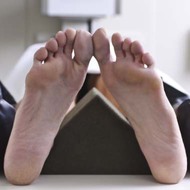

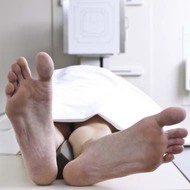
Shielding Guidelines
Accurate gonadal shielding for pelvis and hip examinations is especially critical because of the proximity of radiation-sensitive gonads to the primary rays.
Shielding is easier for males in that small contact shields, such as shown in Fig. 7-34, can be used on all males. These shields are placed over the area of the testes without covering the essential anatomy of the pelvis or hips. However, care must be taken with pelvic radiographs that the top of the shield is placed at the inferior margin of the symphysis pubis to cover the testes adequately without obscuring the pubic and ischial areas of the pelvis.
Ovarian contact shields for females require more critical placement to shield the area of the ovaries without covering essential pelvic or hip anatomy. Vinyl-covered lead material cut into various shapes and sizes can be used for this purpose for an AP pelvis or bilateral hip radiograph, as shown in Fig. 7-36. For a unilateral hip or proximal femur, larger contact shields can be used to cover the general pelvic area without covering the specific hip that is being examined, as shown in Fig. 7-35. Accurate location of the femoral head and neck makes this type of gonadal shielding possible.
Gonadal shielding may not be possible for females on certain AP pelvic projections in which the entire pelvis, including the sacrum and coccyx, must be demonstrated. Also, gonadal shielding may not be possible on lateral inferosuperior hip projections for males and females because shielding may obscure essential anatomy. However, gonadal shielding should be used whenever possible for both males and females, along with close collimation for all hip and pelvic projections. General pelvic trauma requiring visualization of the entire pelvis may prohibit ovarian shielding for females.
Exposure Factors and Patient Dose
To reduce total radiation dose to the patient, a higher kV range of 80 to 85 kV may be used for hip and pelvic examinations. This higher kV technique, with lower mAs, results in a lower radiation dose to the patient. Higher kV, however, decreases contrast (analog imaging only) and may not be advisable, especially for older patients, who may have some loss of bone mass or density caused by osteoporosis; thus, they may require even lower kV than average. Overpenetration with high kV on osteoporotic patients will decrease the visibility of the bony detail when using both analog and digital imaging systems.
Pediatric Applications
Pelvic and hip radiographic examinations are not performed often on children, except on newborns with developmental dysplasia of the hip (DDH). Correct shielding is especially important for infants and children because of the repeat radiographic examinations that are frequently required during the growth of the child. If holding the legs of an infant is required, an individual other than radiology personnel should do this while wearing a lead apron and lead gloves.
The degree and type of immobilization required for older children are dependent on the ability and willingness of the child to cooperate during the procedure. A mummy wrap (see Chapter 16) helps prevent the upper limbs from interfering with the anatomy of interest on a challenging patient. At the very least, tape or sandbags may be required to immobilize the legs at the proper degree of internal rotation.
Geriatric Applications
Geriatric patients are prone to hip fractures resulting from falls and an increased incidence of osteoporosis. As noted earlier, the position of the patient's foot and leg must be observed in trauma cases. It is critical that the injured limb not be moved if the leg is externally rotated. An AP projection of both hips for comparison should be taken first, without movement of the affected limb, to check for fractures. This step may be followed by an inferosuperior (Danelius-Miller) projection of the affected hip.
In nontrauma situations, most geriatric patients require (and appreciate) some immobilization to assist them in holding their feet and legs inverted for the AP pelvis and to support the limb for the lateral projection.
Patients who have undergone hip replacement surgery should not be placed in the frog-leg position for any postsurgical procedures. An inferosuperior lateral is indicated in addition to the AP projection.
Digital Imaging Considerations
The following text provides a summary of the guidelines that should be followed with digital imaging of the procedures described in this chapter:
1. Collimation: Close collimation to the body part being imaged and accurate centering are most important in digital imaging of the hip and pelvis.
2. Exposure factors: It is important that the ALARA principle (exposure to patient as low as reasonably achievable) be followed and the lowest exposure factors required to obtain a diagnostic image be used. This includes the highest kV and lowest mAs that will result in desirable image quality. This may require a higher kV than is used with analog imaging.
3. Post-processing evaluation of exposure indicator: The exposure indicator on the final processed image must be checked to verify that the exposure factors used were in the correct range to ensure an optimum quality image with the least radiation to the patient.
4. Compensating filters: The use of a compensating filter for axiolateral projections of the hip will allow better penetration of the femoral head while preventing overpenetration of the femoral neck and shaft region.
Alternative Modalities
Computed Tomography
CT is useful for evaluating soft tissue involvement of lesions or determining the extent of fractures. CT also is helpful for studying the relationship of the femoral head to the acetabulum before hip surgery or for performing a postreduction study of a developmental hip dislocation.
In general, CT is useful to add to the anatomic or pathologic information already obtained by conventional radiography. For children, the CT examination is useful for examining the relationship of the femoral head to the acetabulum after surgical reduction of a developmental hip dislocation.
Fractures of the pelvic ring missed on conventional radiographic projections, especially those involving the ischial and pubic rami, often are demonstrated during CT scanning.
Magnetic Resonance Imaging
Similar to CT, MRI can be useful for imaging the lower limb or pelvis when soft tissue injuries or possible abnormalities related to joints are suspected. In general, depending on clinical history, MRI may be used when additional information not obtained from conventional radiographs is needed.
Nuclear Medicine
Nuclear medicine bone scans can be useful in providing early evidence of certain bony pathologic processes, such as occult fractures, bone infections, metastatic carcinoma, or other metastatic or primary malignancies. Nuclear medicine is more sensitive and generally provides earlier evidence than other modalities because it assesses the physiologic aspect rather than the anatomic aspect of these conditions.
Clinical Indications
Clinical indications involving the pelvis and hips with which technologists should be familiar include the following (not necessarily an inclusive list):
Ankylosing spondylitis: The first effect demonstrated is fusion of the sacroiliac joints. The disease causes extensive calcification of the anterior longitudinal ligament of the spinal column. It is progressive, working up the vertebral column and creating a radiographic characteristic known as bamboo spine. Males are most often affected.
Avulsion (evulsion) fractures of the pelvis: These fractures cause extreme pain and are difficult to diagnose if not imaged properly. A typical projection is the AP pelvis at between 75 to 85 kV. The lower kV is required to detect a small avulsion fracture. Fractures occur in adolescent athletes who experience sudden, forceful, or unbalanced contraction of the tendinous and muscular attachments, such as might occur while running hurdles. The force of the tendons and muscles sliding over the tuberosities, ASIS, anterior inferior iliac spine (AIIS), superior corner of the symphysis pubis, and iliac crest may cause avulsion fractures.*
Chondrosarcoma: A malignant tumor of the cartilage, it usually occurs in the pelvis and long bones of men older than 45 years. A chondrosarcoma may be completely removed surgically if it does not respond to radiation or chemotherapy.
Developmental dysplasia of the hip (DDH) (older term is congenital dislocation of the hip [CDH]): These hip dislocations are caused by conditions present at birth and may require frequent hip radiographs (see Chapter 16).
Legg-Calvé-Perthes disease: Legg-Calvé-Perthes disease is the most common type of aseptic or ischemic necrosis. Lesions typically involve only one hip (head and neck of femur). The disease occurs predominantly in 5- to 10-year-old boys, and a limp is usually the first clinical sign. Radiographs demonstrate a flattened femoral head that later can appear fragmented.
Metastatic carcinoma: The malignancy spreads to the bone via the circulatory system or lymphatic system, or by direct invasion. Metastatic tumors of the bone are much more common than primary malignancies. Bones that contain red bone marrow are the more common metastatic sites (spine, skull, ribs, pelvis, and femora).
Osteoarthritis: This condition is known as a degenerative joint disease (DJD), with degeneration of joint cartilage and adjacent bone causing pain and stiffness. It is the most common type of arthritis and may be considered a normal part of the aging process. It is common in weight-bearing joints such as the hips, and first evidence is seen on radiographic images of joints such as the hip before symptoms develop, in many persons by age 40. As the condition worsens, joints become less mobile, and new growths of cartilage and bone are seen as osteophytes (bony outgrowths).
Pelvic ring fractures: Because of the closed ring structure of the pelvis, a severe blow or trauma to one side of the pelvis may result in a fracture site away from the site of primary trauma, thus requiring clear radiographic visualization of the entire pelvis.
Proximal femur (hip) fractures: These fractures are most common in older adult or geriatric patients with osteoporosis or avascular necrosis. Both osteoporosis (loss of bone mass from metabolic or other factors) and avascular (loss of blood circulation) necrosis (cell death) frequently lead to weakening or collapse of weight-bearing joints such as the hip joint; fractures occur with only minimal trauma.
Slipped capital femoral epiphysis (SCFE): This condition usually occurs in 10- to 16-year-olds during rapid growth, when even minor trauma can precipitate its development. The epiphysis appears shorter and the epiphyseal plate wider, with smaller margins.
Routine and Special Procedures
Certain routine and special projections or positions for the proximal femora and pelvis are demonstrated and described on the following pages as suggested standard and special departmental procedures.
Pelvis Radiographic Guide
The following guide is provided as a suggested sequence of possible routine and special projections of the proximal femur and pelvis, as described and illustrated in this textbook. The routine AP pelvis is considered the initial baseline evaluation projection for hip or general pelvic pathologic processes or trauma. This projection is followed by additional lateral projections for the hip and proximal femur or additional special projections of the pelvis for possible trauma to other parts of the pelvis.
The entire AP pelvis is considered routine for a possible hip fracture, even if the side of injury is known, so that both hips can be demonstrated for comparison purposes.
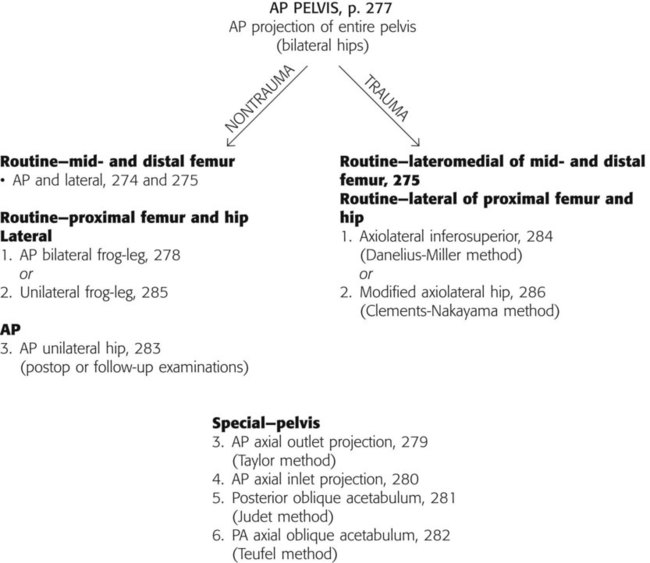
AP Projection: Femur—mid- and Distal
NOTE: If the site of interest is in the area of the proximal femur, a unilateral hip routine or pelvis is recommended, as described in this chapter.
Part Position 
• Align femur to CR and to midline of table or IR.
• Rotate leg internally about 5° for a true AP, as for an AP knee. (For proximal femur, 15° to 20° internal leg rotation is required, as for an AP hip.)
• Ensure that knee joint is included on IR, considering the divergence of the x-ray beam. (Lower IR margin should be approximately 2 inches [5 cm] below knee joint.)
CR
Collimate closely on both sides to femur with end collimation to film borders.
Routine to include both joints: Common departmental routines include both joints on all initial femur exams. For a large adult, a second smaller IR then should be used for an AP of the knee or hip, ensuring that both hip and knee joints are included. If the hip is included, the leg should be rotated 15° to 20° internally to place the femoral neck in profile.
Lateral-Mediolateral or Lateromedial Projections: Femur—mid- and Distal
NOTE: For possible trauma, if the site of interest is in the area of the proximal femur, a unilateral trauma hip routine is recommended. For nontrauma, lateral of proximal femur (see p. 284).
Part Position 
Lateral Recumbent (Fig. 7-39)
WARNING: Do not attempt this position if patient has severe trauma.
• Flex knee approximately 45° with patient on affected side, and align femur to midline of table or IR.
• Place unaffected leg behind affected leg to prevent over-rotation.
• Adjust IR to include knee joint (lower IR margin should be approximately 2 inches [5 cm] below knee joint). A second IR to include the proximal femur and hip generally will be required on an adult (see p. 276).
Trauma Lateromedial Projection (Fig. 7-40)
Lateral-Mediolateral Projection: Femur—mid- and Proximal
WARNING: Do not attempt this position for patients with possible fracture of the hip or proximal femur. Refer to trauma lateral hip routine in this chapter.
Part Position 
• Flex affected knee about 45° and align femur to midline of table. (Remember the proximal and midportions of the femur are nearer to the anterior aspect of the thigh.)
• Extend and support unaffected leg behind affected knee and have patient roll back (posteriorly) about 15° to prevent superimposition of proximal femur and hip joint.
• Adjust IR to include hip joint, considering the divergence of the x-ray beam. (Palpate ASIS and place upper IR margin at the level of this landmark.)
CR
AP Pelvis Projection (Bilateral Hips): Pelvis
WARNING: Do not attempt to rotate legs internally if a hip fracture or dislocation is suspected. Perform position with minimal movement of affected leg
Part Position 
• Align midsagittal plane of patient to centerline of table and to CR.
• Ensure that pelvis is not rotated; distance from tabletop to each ASIS should be equal.
• Separate legs and feet, then internally rotate long axes of feet and lower limbs 15° to 20° (see warning earlier). Technologist may have to place sandbag between heels and tape top of feet together or use additional sandbags against feet to retain this position.
CR
CR is perpendicular to IR, directed midway between level of ASIS and the symphysis pubis. This is approximately 2 inches (5 cm) inferior to level of ASIS (see Note).
AP Bilateral Frog-Leg Projection: Pelvis
Modified Cleaves Method
WARNING: Do not attempt this position on a patient with destructive hip disease or with potential hip fracture or dislocation.
Part Position 
• Align patient to midline of table and/or IR and to CR.
• Ensure pelvis is not rotated (equal distance of ASIS to tabletop).
• Center IR to CR, at level of femoral heads, with top of IR approximately at level of iliac crest.
• Flex both knees approximately 90°, as demonstrated.
• Place the plantar surfaces of feet together and abduct both femora 40° to 45° from vertical (see Note 2). Ensure that both femora are abducted the same amount and that pelvis is not rotated.
• Place supports under each leg for stabilization if needed.
CR
• CR is perpendicular to IR, directed to a point 3 inches (7.5 cm) below level of ASIS (1 inch [2.5 cm] above symphysis pubis).
Suspend respiration during exposure.
NOTE 1: This projection frequently is performed for periodic follow-up examinations on younger patients. Correct placement of gonadal shielding is important for male and female patients, ensuring that hip joints are not obscured.
NOTE 2: Less abduction of femora of only 20° to 30° from vertical provides for the least foreshortening of femoral necks, but this placement foreshortens the entire proximal femora, which may not be desirable.
AP Axial Outlet Projection* (for Anterior-Inferior Pelvic Bones): Pelvis
Taylor Method
AP Axial Inlet Projection*: Pelvis
Posterior Oblique Pelvis–acetabulum
Judet Method
Clinical Indications
Right and left oblique projections generally are taken for comparison, with both centered for upside or both for downside acetabulum. Both sides may have to be demonstrated on a single 14- × 17-inch (35- × 43-cm) IR. In this case, centering should be adjusted to include both hips.
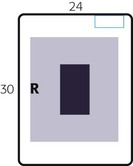
Pa Axial Oblique Projection–acetabulum
Teufel Method
Clinical Indications
Right or left posterior oblique is taken to demonstrate the side of interest, centered to the downside acetabulum to demonstrate the hip joint and acetabulum in the center of the image, with the femoral head in profile. The concave area of the fovea capitis should be demonstrated, along with the superoposterior wall of the acetabulum.

AP Unilateral Hip Projection: Hip and Proximal Femur
WARNING: Do not attempt to rotate legs if fracture is suspected. An AP pelvis projection to include both hips for comparison should be completed before an AP unilateral hip is performed for possible hip or pelvis trauma.
CR
• CR is perpendicular to IR, directed to 1 to 2 inches (2.5 to 5 cm) distal to midfemoral neck (to include all of orthopedic appliance of hip, if present). Femoral neck can be located about 1 to 2 inches (3 to 5 cm) medial and 3 to 4 inches (8 to 10 cm) distal to ASIS (see p. 269).
Axiolateral Inferosuperior Projection: Hip and Proximal Femur—trauma
Danelius-Miller Method
WARNING: Do not attempt to rotate leg internally on initial trauma examination.
NOTE: This is a common projection for trauma, surgery, and postsurgery patients, as well as for other patients who cannot move or rotate the affected leg for frog-leg lateral.
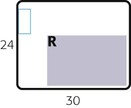
Technical Factors
• Minimum SID is 40 inches (102 cm).
• IR size—24 × 30 cm (10 × 12 inches), crosswise (LW to long axis of femur)
• Grid (grid perpendicular to the CR to prevent grid cutoff)
May be done on stretcher or bedside if patient cannot be moved (see Chapter 15). Patient is supine, with pillow provided for head; elevate pelvis 1 to 2 inches (3 to 5 cm) if possible by placing supports under pelvis (more important for thin patients and for patients on a soft pad or in a bed).
Part Position 
• Flex and elevate unaffected leg so that thigh is near vertical position and outside collimation field. Support in this position. (Do NOT place leg on collimator or x-ray tube due to risk of burns or electrical shock).
• Check to ensure no rotation of pelvis (equal ASIS-table distance).
• Place IR in crease above iliac crest and adjust so that it is parallel to femoral neck and perpendicular to CR. Use cassette holder if available, or use sandbags to hold cassette in place.
• Internally rotate affected leg 15° to 20° unless contraindicated by possible fracture or other pathologic process (see warning above).
Unilateral Frog-Leg Projection—mediolateral: Hip and Proximal Femur
Modified Cleaves Method
WARNING: Do not attempt this position on patient with destructive hip disease or potential hip fracture or dislocation. This could result in significant displacement of fracture fragments (see lateral trauma projections).
Part Position 
• Flex knee and hip on affected side, as shown, with sole of foot against inside of opposite leg, near knee if possible.
• Abduct femur 45° from vertical for general proximal femur region (see Note 1).
• Center affected femoral neck to CR and midline of IR and tabletop. (Femoral neck is 3 to 4 inches [7.5 to 10 cm] distal to ASIS.)
CR
CR is perpendicular to IR (see Note 2), directed to midfemoral neck (center of IR).
Suspend respiration during exposure.
NOTE 1: The optimum femur abduction for demonstration of the femoral neck without any foreshortening is 20° to 30° from vertical on most patients. This results in significant foreshortening of the proximal femur region, which may be objectionable.
NOTE 2: A modification of this position is the Lauenstein-Hickey method, with the patient starting in a similar position, then rotating onto affected side until the femur is in contact with the tabletop and parallel to the IR. This position foreshortens the neck region but may demonstrate the head and acetabulum well if affected leg can be abducted sufficiently, as shown in Fig. 7-71, inset.
Modified Axiolateral—possible Trauma Projection: Hip and Proximal Femur
Clements-Nakayama Method*
Part Position 
• Maintain leg in neutral (anatomic) position (15° posterior CR angle compensates for internal leg rotation).
• Rest IR on extended Bucky tray, which places the bottom edge of the IR about 2 inches (5 cm) below the level of the tabletop.
• Tilt IR about 15° from vertical and adjust alignment of IR to ensure that face of IR is perpendicular to CR to prevent grid cutoff.
Radiographs for Critique
Students should determine whether they can critique each of these four radiographs based on the categories described in the textbook and outlined on the right. As a starting critique exercise, place a check in each category that demonstrates a repeatable error for that radiograph.
Answers are also provided in the Appendix at the end of this textbook.
| PARAMETER | Radiographs | |||
| A | B | C | D | |
| 1. Anatomy demonstrated | ________ | ________ | ________ | ________ |
| 2. Positioning | ________ | ________ | ________ | ________ |
| 3. Collimation and CR | ________ | ________ | ________ | ________ |
| 4. Exposure | ________ | ________ | ________ | ________ |
| 5. Markers | ________ | ________ | ________ | ________ |
